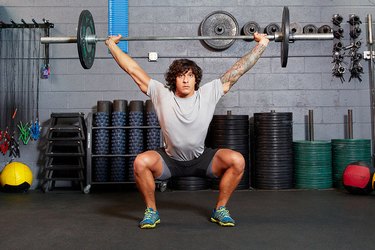
Squats are the ultimate customizable exercise. Performed by bodybuilders, powerlifters, Olympians and everyday gym goers on a regular basis, this compound exercise is among the most useful and effective for strengthening your lower body.
When programming squats into your training routine, there are a number of variations to consider based on your individualized goals. The regular and sumo squat variations are two surefire ways to get your quad, hamstring and glute muscles working. When you're ready, add some resistance and incorporate squats into your weekly routine.
Video of the Day
Video of the Day
Read more: The Two Best Exercises You're Not Doing
Differences Between Sumo Squats and Regular Squats
The main difference between the two exercises is the placement of your feet, according to the American Council on Exercise (ACE). During a regular squat, the feet are placed shoulder-width apart, and the toes face forward or slightly out. When doing a sumo squat, the feet are in a wide stance with the toes turned out at about a 45 degree angle.
Because of the foot positioning, the muscles emphasized in each of these variations differs, too. Both work the glutes, quadriceps, hamstrings, hip flexors and calves. However, the sumo squat places more emphasis on the inner thigh adductors, which move your legs in toward your body, according to ACE.
Depending on your core strength, you may also find sumo squats an additional challenge to your balance, as you're putting your body into a new alignment and need stability to keep from rocking forward or back on your heels.
How to Perform a Regular Squat
Before moving ahead to a sumo squat or other squat variations, it's important to master your form for the standard squat. Try this move in front of a mirror to check your form. If you notice your knees caving in at the bottom of the squat, place a resistance band above your knees. Consciously resist the band as you squat to keep it from falling.
- Stand up straight with your feet hip-width apart and your hands by your sides.
- Hinge at your knees and hips as if you were sitting back into a chair and raise your arms so they're parallel to the floor to help with your balance.
- At the bottom of the squat, your thighs should be parallel to the floor (or lower if hip flexibility allows), and your knees should remain in line with your ankles, not flaring out to the side or caving in toward the midline of your body.
- Keep your back straight the entire time, and all four corners of your feet anchored firmly to the ground.
- Press through your heels and stand up straight.
Depending on your fitness level, start out with three sets of 10 reps and build from there.
Read more: The 30-Day Squat Challenge
How to Perform a Sumo Squat
- To perform a sumo squat, stand with your feet significantly wider than hip-distance apart (about three to four feet), turn your toes out 45 degrees and hold your hands by your sides.
- Lower yourself down by bending your knees and hips, raising your hands to meet under your chin. Keep your abs tight, back straight and do not let your knees travel past your toes when lowering. It is very important that hip, knee and ankle alignment be maintained.
- Once your thighs parallel the floor, root through your heels and rise back up steadily for one rep.
- Again, depending on your fitness level and goals, start out with three sets of eight reps and building from there once you get more comfortable with them.
Check out more expert tips on how to do a sumo squat.
Adding Resistance to Squats
As you learn the mechanics of the standard squat and sumo squat, your own body weight is sufficient resistance for the exercise. With practice, as you grow more comfortable with the movement pattern, you have the option of adding resistance to increase the challenge. Before you add resistance or weight to your squats, be sure that you've mastered proper form and range of motion so that you can avoid injury.
Begin progressing your body-weight squats with dumbbells. Hold one in each hand and keep your arms along the sides of your body as you move through the range of motion. For sumo squats, use both hands to hold one dumbbell in front of you so that it hangs just below your pelvis. Alternatively, you can hold a dumbbell, kettlebell or weight plate in the center of your chest with both hands to perform a goblet squat.
As you become more comfortable using dumbbells to challenge your squats, begin to introduce the barbell. Before you begin to rack up loads on your barbell, try several repetitions with only the bar. Place the barbell behind your head and across your upper back and shoulders for a back squat. If you're confident in your form, add a few plates on each size to add more difficulty.
For a front squat (an even more advanced version), rest the bar at the very top of your shoulders, practically touching your throat. If you have the wrist flexibility, place your hands right outside your shoulders, elbows raised to shoulder height.
If you struggle to keep your elbows up in this position, try the bodybuilder grip. Bring your elbows to shoulder height and cross your arms in front of you, gripping the barbell near opposite shoulders. Regardless of grip preference, remember that your shoulders are keeping the barbell from falling so don't let them droop.
Was this article helpful?
150 Characters Max
0/150
Thank you for sharing!
Thank you for your feedback!